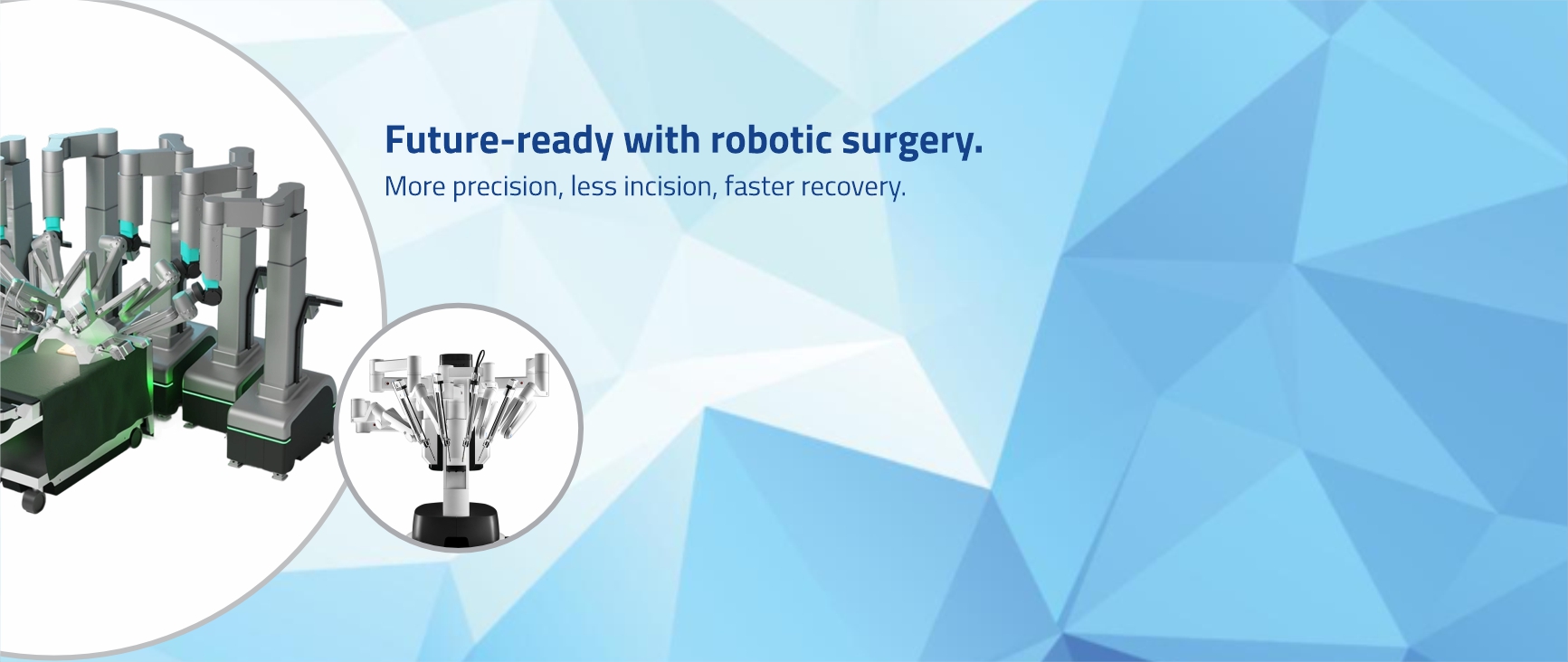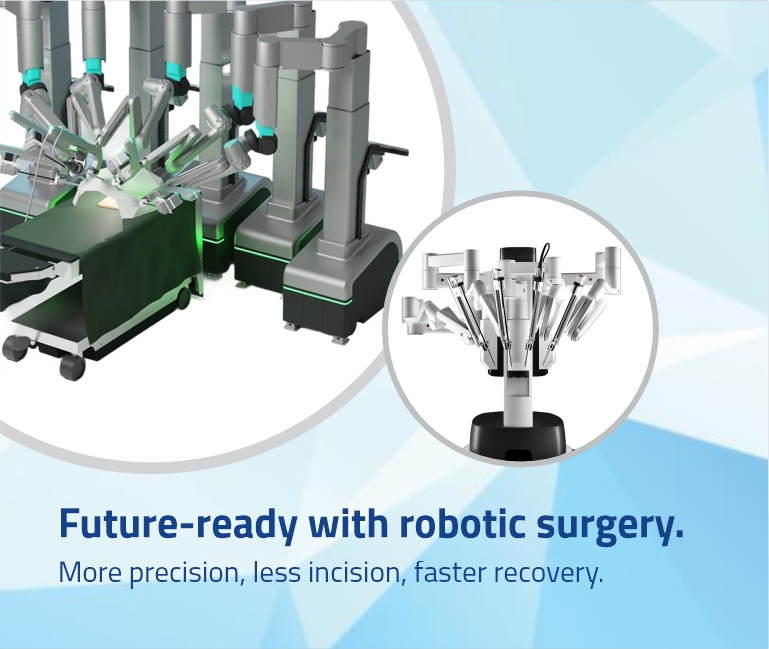The term Robotic Surgery has patients visualizing a futuristic operating room manned by complex-looking robots programmed to undertake advanced operating procedures on humans, like seen in science fiction movies set in the future! But technology that is yet to perfect driverless cars is still far from developing robots that can replace human surgeons! What robotic surgery refers to is robot-assisted surgery, which allows surgeons to perform many types of complex procedures with more precision, flexibility, and control than is possible with conventional techniques. Robotic surgery does not refer to an automated surgical system but one remotely controlled by a human surgeon. While the robots do not perform any surgeries on their own, they offer greater precision than handheld tools, particularly in hard-to-access parts of the body. At the core of robotic surgery is an experienced surgeon trained to use the robotic system for complex surgical procedures. The surgeon is in total control of the surgical system at all times.
SSI Mantra 3 Robotic System at Aster CMI Hospital
Aster CMI Hospital is equipped with the SSI Mantra 3 Robotic Surgical System, India's first indigenous, modular, and cost-effective robotic surgery platform. Developed by SS Innovations, this state-of-the-art system provides world-class robotic-assisted surgery with advanced features tailored for various surgical specialties. The SSI Mantra 3 is designed to improve precision, enhance visualization, and ensure superior ergonomics for the surgeon. It incorporates features like articulating instruments, high-definition 3D vision, and AI-driven safety mechanisms to facilitate minimally invasive procedures with greater accuracy. This cutting-edge robotic system is revolutionizing robotic surgery in India by making advanced robotic-assisted surgeries more accessible and cost-effective for patients.
The SSI Mantra 3 is widely used in procedures across multiple specialties, including Urology, Oncology, Gastroenterology, Cardiothoracic Surgery, Gynaecology, and Paediatric Surgery at Aster CMI Hospital. With its enhanced dexterity and precision, the system allows surgeons to perform highly complex surgeries with minimal invasiveness, leading to faster recovery, reduced complications, and superior surgical outcomes.
da Vinci Surgical System at Aster CMI Hospital
In addition to the SSI Mantra 3, Aster CMI Hospital also utilizes the da Vinci Surgical System, a globally recognized robotic surgery platform. The da Vinci Surgical System was developed using telepresence robotic technology pioneered by NASA and the Scripps Research Institute. It was named after Leonardo da Vinci, the 15th-century inventor, painter, and philosopher who conceptualized the first robotic mechanisms and used anatomical accuracy in his works.
The da Vinci system enables the surgeon to use tiny robotic tools, which allow for much smaller incisions and visual enhancements such as infrared imaging to provide critical surgical insights beyond human vision. The system consists of three main components:
- Vision System – Includes the endoscope, cameras, and equipment that produce a 3D image of the operating area.
- Patient-Side Cart – Houses the robotic arms with EndoWrist technology, which mimics human hand and wrist movements.
- Surgeon Console – Allows the surgeon to visualize the operating area and manipulate the robot’s surgical instruments.
During a da Vinci robotic-assisted surgical procedure, the surgeon sits at the console, viewing a high-definition, 3D image of the patient’s target anatomy. The surgeon’s hand, wrist, and finger movements at the console are translated into precise, real-time movements of surgical instruments attached to the robotic arms. The system enhances dexterity, minimizes human tremors, and improves surgical precision.
Benefits of Robotic Surgery
For Patients
Robotic surgery is a minimally invasive surgery (MIS) that is performed through small incisions instead of conventional open surgery requiring large cuts. The benefits for patients include:
- Less pain and minimal blood loss
- Smaller scars with improved cosmetic outcomes
- Lower risk of surgical site infections and complications
- Faster recovery, reducing hospital stays and post-operative care
- Quicker return to daily activities, benefiting working professionals and daily wage earners
- For instance, in Head and Neck Surgery, robotic-assisted procedures for tongue and mouth cancers, which are highly prevalent in India, provide better outcomes, less pain, and minimal scarring.
For Surgeons
Robotic-assisted surgery enhances surgical precision and control by providing:
- Greater flexibility, dexterity, and range of motion compared to traditional laparoscopic instruments
- 3D magnified visualization, offering superior clarity of the surgical site
- Firefly™ Fluorescence Imaging technology, which differentiates healthy and diseased tissue using near-infrared imaging
- Tremor filtration and motion scaling, ensuring delicate and precise surgical maneuvers
- Multi-instrument capability, enabling simultaneous use of three surgical instruments
Robotic surgery has now replaced traditional open surgery in many medical fields, particularly Urology, Gynaecology, Cardiothoracic Surgery, and Oncology. It is widely used for procedures such as prostatectomies, nephrectomies, hysterectomies, and cardiac valve repairs.
Robotic Surgery at Aster CMI Hospital
At Aster CMI, the option of robotic surgery is available across various departments, including:
- Urology
- Cardiothoracic Surgery
- Gynaecology
- Oncology
- Gastroenterology
- Integrated Liver Care (Transplants)
- Bariatric Surgery
- Paediatric Surgery
The Future of Robotic Surgery
The future of robotic surgery extends beyond operating rooms into tele-medicine and long-distance robotic-assisted operations. With advancements in robotics, AI, and 5G connectivity, the concept of remote surgeries will soon become a reality. This means a surgeon in Bengaluru could operate on a patient in another city, state, or even a different country using robotic-assisted technology. As robotics continues to evolve, the possibilities for medical innovation and patient care are limitless.



